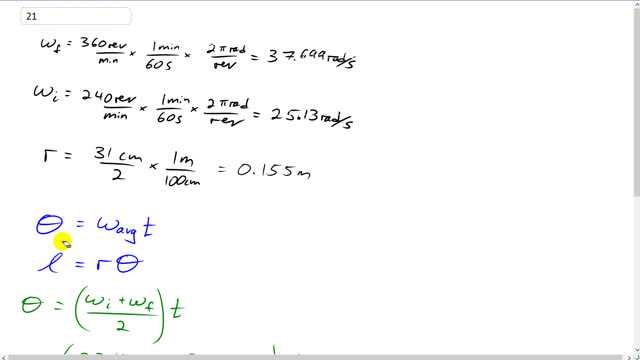
A wheel 31 cm in diameter accelerates uniformly from 240 rpm to 360 rpm in 6.8 s. How far will a point on the edge of the wheel have traveled in this time?

In order to watch this solution you need to have a subscription.
This is Giancoli Answers with Mr. Dychko. The distance a point on the edge of a wheel will travel is gonna be l equal to radius of the wheel times the angular displacement of the wheel— the angle in radians over which the wheel rotates. So to figure out angular displacement, we need to take the average angular velocity, multiply it by time and that gives us Θ, the angular displacement. And we'll take care of all our unit conversion first up here: we have the final angular velocity of this wheel is gonna be 360 revolutions per minute times 1 minute for every 60 seconds times 2π radians for every revolution giving us 37.699 radians per second and it starts at 240 revolutions per minute which converts to 25.13 radians per second. And the radius of the wheel is 31 centimeters divided by 2— that's the diameter 31, divided by 2 to get the radius— and then converted into meters and we get 0.155 meters. So angular displacement is the initial plus the final angular velocities divided by 2 multiplied by 6.8 seconds—the amount of time over which this acceleration happens— and that gives us 213.62 radians. And then multiply that angular displacement by 0.155 meters radius that gives 33 meters is the distance a point on the edge of the wheel travels.
how does meters x radians = meters in the end?
Radians are a ratio of meters divided by meters. They're a ratio of the arc length of a circle, divided by the radius of that circle. Since radians are a ratio of meters divided by meters, this makes radians dimensionless. Radians have no units, in other words, so multiplying them by something with units doesn't change the units. Multiplying radians (no units) by meters, makes meters.
I tried to solve for theta (angular displacement) using theta=Winitial*time +(1/2alphat^2). Can you tell me why this is not a correct approach? I got the wrong answer doing it this way. I am just trying to figure out when to use the various equations. I am also not clear yet on when to use lowercase L, as I thought this was the arclength.
Hi acw, thank you for the question. Your approach is totally correct! If you're getting the wrong answer, then I suspect it has to do with an oversight somewhere along the chain of calculations. This approach requires more calculation (finding angular acceleration in other words) which is the only drawback of using that formula. It's hard to guess where the error is, but it will come out to the same answer eventually.
All the best,
Shaun